You can leave a food dehydrator running overnight to totally remove moisture from food. However, you must ensure that the food you dehydrate will take at least 8 hours to dry. Otherwise, you could overheat the food and damage the machine.
I never saw the need for a dehydrator, but the Covid Lockdown changed everything. I couldn’t afford to waste my food supply or run out of the fruits when their seasons ended, So I opted to dry them using a food dehydrator. It worked flawlessly for me. And I still use my food dehydrator to preserve various items such as meats, herbs, pasta, veggies, fruits, and even soups.
They make delicious snacks and meals without any cooking required. In fact, they’re so simple to use that even children can operate them!
But here’s the thing… Most people don’t know how long they should leave food in the dehydrator or if it’s safe to leave it on overnight.
So, In this article, I’ll explain everything you need to know about running your food dehydrator for long periods, and I’ll also share tips to help you safely use this unique appliance.
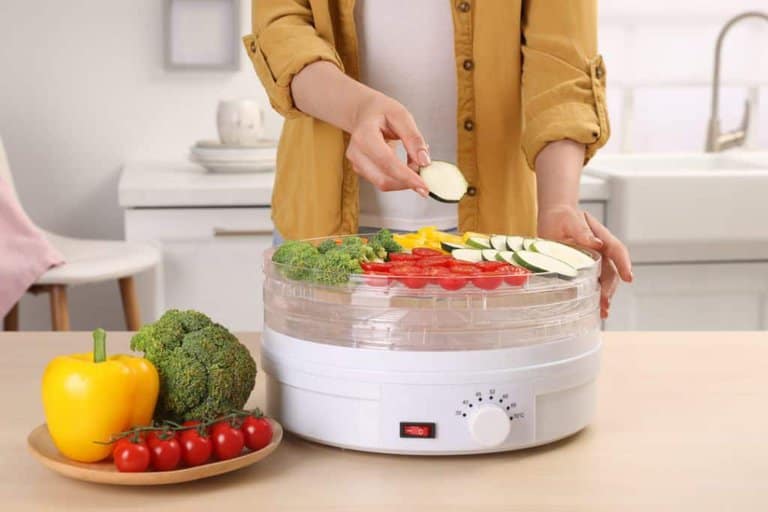
How Does A Food Dehydrator Work?
Except you’re a first-time user, you’re probably familiar with how a dehydrator works. So I’ll be brief in discussing its mechanics.
A food dehydrator is designed and operates similarly to an oven. The main difference is that instead of using heat for cooking food, the dehydrator circulates air at very low temperatures to pull moisture out of foods and dry them. The goal is to keep the food fresh for as long as possible while retaining its flavor and nutritional content.
They’re great for drying vegetables, herbs, nuts, seeds, meats, fish, and poultry. They’re also great for preserving foods, making jerky, and creating dried fruit snacks.
The dehydrator can run for several hours or even days, depending on the processed food. Each variety of food has a different drying temperature;
Now, let’s take a look at the two types of food dehydrators;
The Vertical Flow Dehydrator
Also known as the stacked shelf dehydrator, the vertical dehydrator has its heat source at the top or bottom of the device.
These dehydrators are great because they’re compact, portable, and efficient. They work well for small batches of food, such as fruits and vegetables, and they’re perfect for camping trips, picnics, and tailgating events.
Common Features
- Airflow is vertical; hence heat distribution may be unequal.
- Requires manual effort (flipping food) to heat food on all sides.
- Works well for fruits and vegetables, although it may take longer to dry meat.
- It is usually less expensive and takes up less space in your kitchen.
Horizontal Flow Dehydrator
A horizontal flow dehydrator is similar to a regular oven in design. The heat source is located at the back to ensure greater air circulation. However, this machine has a much wider base, allowing food to dry on both sides.
Common Features
- Distributes heat evenly because the airflow is horizontal.
- It is simpler to operate and requires no manual effort once activated.
- Dehydrates any form of food, including meats, fruits, and vegetables.
- Typically more costly than the vertical model.
- Larger in size and takes up more kitchen space.
How To Dehydrate Food
Dehydrating food is an excellent way to preserve your food without spending a fortune on expensive packaging supplies. In addition to saving money, dehydrated foods also have a longer shelf life than fresh ones.
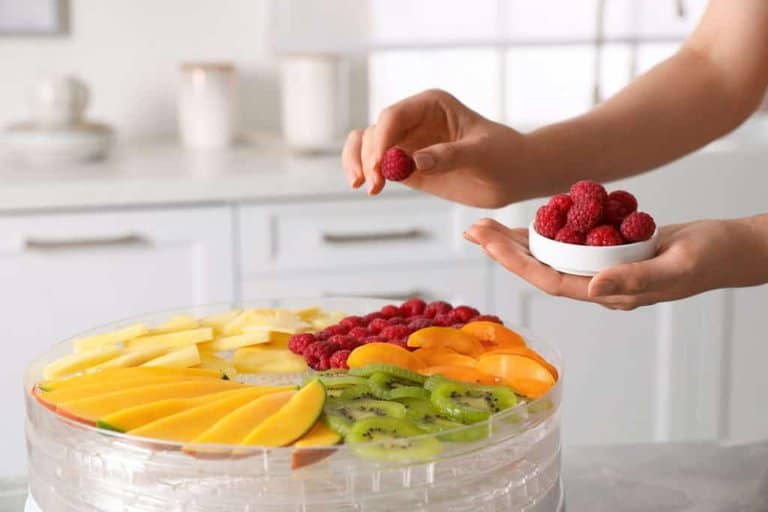
To dry your food safely using a food dehydrator, follow these simple procedures:
Step 1: Preparing The Food
Different foods need different preparation methods.
- Start by washing your fruits, vegetables, and meats. Cut food into uniform pieces using the proper tools. (Food should not be too thick or thin).
- If possible, cut off the ends of fruit and veggies, so they don’t rot during the drying process.
- Cutting tools like knife, grater, hand peeler, and food processor will be handy for peeling and slicing fruits and meats.
- Before putting your veggies, fruits, and meats in the dehydrator, blanch them for 2-5 minutes.
Step 2: Organize The Food In The Dehydrator
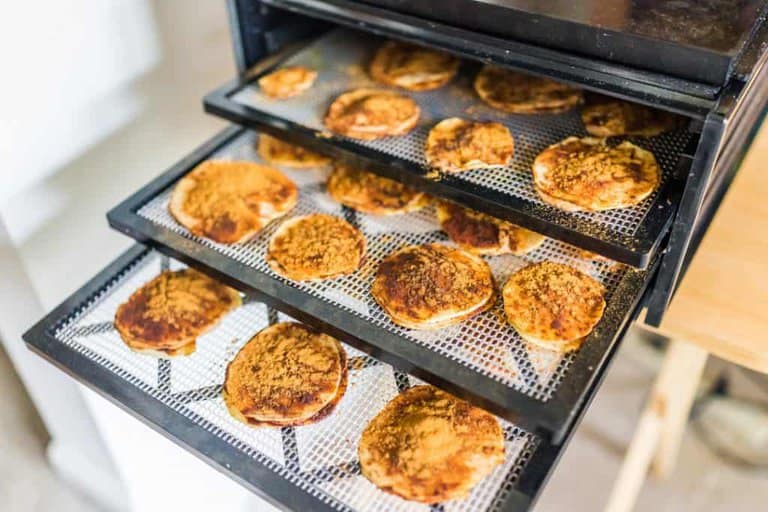
- Arrange your food evenly on trays that fit inside the dehydrator. Avoid overlapping as much as possible.
- Make sure there’s plenty of room between each piece of food. Leave at least 1/8 inch between each piece.
- Also, make sure the trays are clean and free of debris.
Step 3: Dehydrating Food
The drying time and temperature will vary greatly based on the food.
- Set the desired temperature setting on the dehydrator. Depending on what kind of food you’re drying, you may need to adjust the settings.
- Most fruits are dehydrated at 135°F. Some fruits may get done in less than 6 hours, while others might take days.
- Vegetables should be dehydrated at 125°F for 4 to 12 hours.
- Cooked foods like rice and grains should be dried at 145°F for 6-12 hours, whereas beans and pasta should be dehydrated at 125°F.
- Cooked beef should also be dehydrated for 6-12 hours at 145°F.
- Keep in mind that the higher the temperature, the faster the food will dry. The lower the temperature, the slower the food will dry.
Is It Safe To Leave Your Food Dehydrator On Overnight?
It can take up to 12 hours for some foods to dehydrate properly. This means that you may have to leave your dehydrator on overnight. However, turning the dehydrator on at night is generally not advisable to avoid any potential fire hazards resulting from overheating.
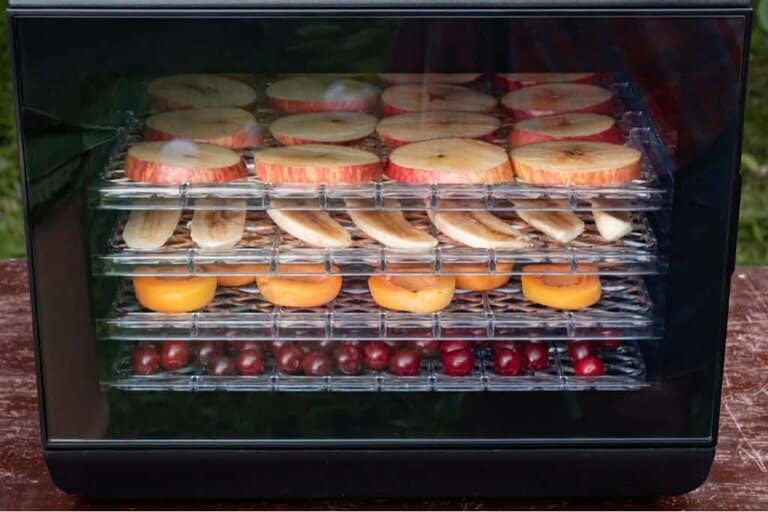
If you do choose to do so, please follow the safety guidelines below.
Tips For Using A Food Dehydrator Unattended
- When leaving the dehydrator on overnight, use the automatic shutoff function.
- Place the dehydrator on a heat-resistant countertop in a well-ventilated area of your kitchen.
- Keep towels and flammable objects away from the countertop.
- Keep dishes, kitchenware, and water away from the appliance.
- Read all the instructions before starting your first time. Doing so will give you peace of mind knowing that you have everything you need to get started right.
How To Store Dehydrated Foods
After drying, the next step is to preserve your food for later use. And when properly stored, dehydrated foods can last for years.
- Rice, cereals, and beans may be stored for up to a year.
- Vegetables can be stored for 6 months to a year.
- Meat can also be frozen for up to 6 months.
The following are essential steps to follow when storing dried food.
Cool Food To Room Temperature
- Before storing your dried food, allow it to cool to room temperature. This will help balance the moisture content of the food and keep it safe. This step is also known as conditioning.
Checking The Food
- You may need to keep an eye on your food for a few hours or days before storing it. This is to look for signs of moisture or condensation.
- If there is still moisture, return the food to the dehydrator to dry a bit further.
- Continue checking every few hours until the food is completely dried.
- Once you’re sure the food is clear of moisture, you may package it for storage.
Storage
You can store your dry food using any of the methods or materials listed below.
- Airtight Containers: Keep your food in an airtight plastic or glass container.
- Vacuum-Sealed Bags: This is suitable for long-term storage.
- Resealable Containers: You can store your dried foods in a zip-top bag for backpacking trips. This method is not suitable for long-term storage.
Quick Tip: Label your containers with the recipe’s name and the date you prepared the meal. This will help you keep tabs on your food’s shelf life.
Temperature
The temperature at which you store your food might affect its shelf life. Generally, food kept at 60°F lasts longer than food stored at 80°F. Also, store your food in a cold, dry, dark, and well-ventilated place.
Benefits Of Owning A Food Dehydrator
While you can use other kitchen appliances such as the oven or microwave to dry food, a food dehydrator is recommended for the best results, as it is designed specifically for this purpose. In addition, it minimizes the chance of food damage.
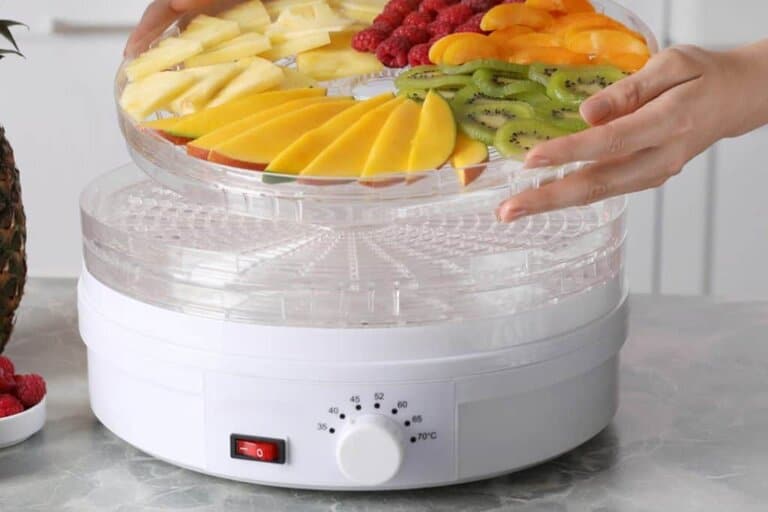
The following are the major benefits of using a dehydrator:
- First, having a dehydrator reduces food waste.
- Second, dehydrators are simple to use and have simple settings.
- A food dehydrator also removes moisture from food without altering its nutritional value or flavor.
- Unlike other drying methods, a dehydrator not only removes moisture from your food but also reduces the possibility of bacteria growth.
- Foods processed in a dehydrator are entirely healthy and natural.
- Unlike other drying methods, a dehydrator gives you more control over the process and decreases the danger of food damage.
- When you dehydrate food yourself, you can do so with care and precision, without using preservatives and other chemicals that may be hazardous in the long term.
- Dehydrating your food is less expensive than purchasing store-bought meals.
- Dehydrated foods are often flexible, lightweight, and easy to store, lowering storage space requirements.
- Unlike other drying methods, the dehydrator allows you to dry your food even when you are away. It operates at a low temperature and with accuracy.
FAQs On Can You Leave A Food Dehydrator On Overnight
Can I Dehydrate Different Foods In The Same Dehydrator?
Yes, you can dry many foods at once in a dehydrator. For example, large dehydrators often contain two or more trays to accommodate different items, such as fruits and vegetables, together. And multiple fruits may be dried simultaneously without their flavors blending.
Can A Food Dehydrator Catch Fire?
Food dehydrators are not often a fire threat, but if their electrical components are malfunctioning or there is an issue with your home’s power supply, they can pose a risk.
How Do I Choose the Best Food Dehydrator?
Choosing the best food dehydrator should be based on the food you want to dry, the space of your kitchen, and your budget. A vertical flow dehydrator is cheaper and ideal for fruits and vegetables, while a horizontal flow dehydrator is costly but better for meats.